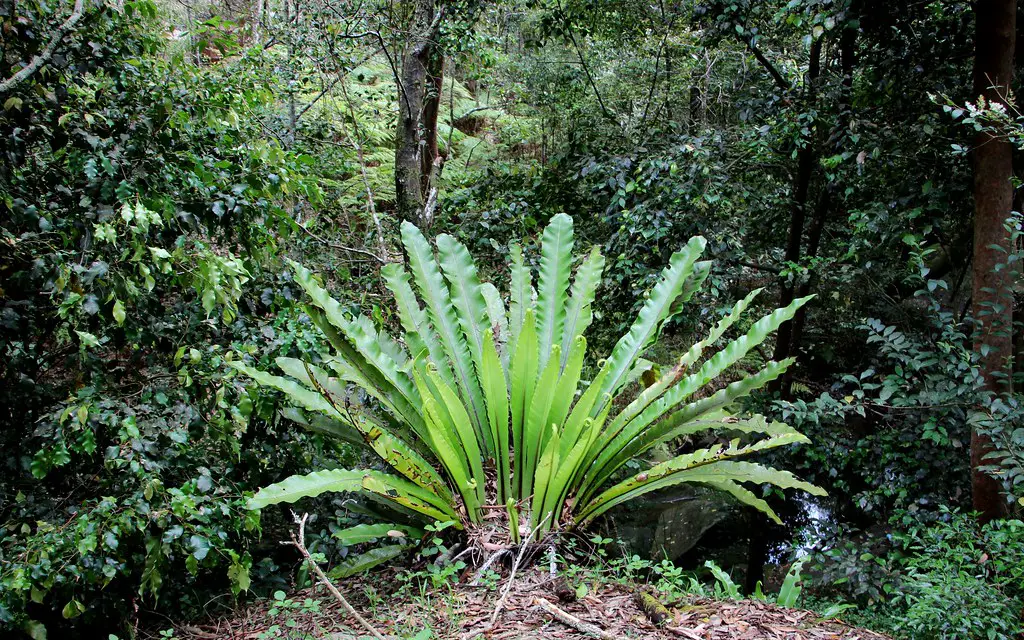The Bird’s Nest Fern (Asplenium nidus) is a strikingly beautiful fern with a unique growth pattern. Its fronds radiate outwards in a nest-like circular pattern, giving it a distinctive appearance. This lush green plant is native to tropical regions of Southeast Asia, Australia, and Hawaii, where it’s often found in rainforests and humid environments.
Appreciated for its adaptability and resilience, the Bird’s Nest Fern is a popular houseplant. Its leathery, lance-shaped fronds can grow quite large and are often used to add a tropical touch to interior spaces. Unlike many ferns, this plant does not have the typical feathery fronds but instead sports simple, whole fronds that make it look different from its relatives.
An epiphytic plant by nature, the Bird’s Nest Fern often grows on trees in its native habitat. This way of growing means that the plant doesn’t rely on soil for its nutrients, making its care somewhat unique compared to other houseplants. Whether you’re an experienced plant lover or a beginner, the Bird’s Nest Fern can be a fascinating addition to your collection.
| Attribute | Details |
|---|---|
| Common Names | Bird’s Nest Fern, Nest Fern |
| Botanical Name | Asplenium nidus |
| Family | Aspleniaceae |
| Plant Type | Evergreen, Perennial |
| Mature Size | 1-3 feet tall and wide |
| Sun Exposure | Indirect light, Shade |
| Soil Type | Well-drained, humus-rich |
| Hardiness Zones | 11-12 |
| Native Area | Southeast Asia, Australia, Hawaii |
Bird’s Nest Fern Care
Caring for a Bird’s Nest Fern is relatively straightforward and manageable. Its unique growth pattern and striking appearance make it a wonderful addition to any space, and it can thrive indoors with proper care.
A critical aspect of caring for the Bird’s Nest Fern is understanding its native environment. This plant prefers high humidity, indirect light, and consistent moisture. While it can tolerate some neglect, ensuring the right balance of these elements will make your fern thrive. Providing proper soil, adequate light, and the right amount of water will keep this plant happy and healthy.
Light Requirement for Bird’s Nest Fern
The Bird’s Nest Fern prefers bright, indirect light. Direct sunlight can scorch its leaves, so placing it in a spot with filtered or diffused light is ideal. It can also adapt to lower light levels but may grow more slowly.
Soil Requirements for Bird’s Nest Fern
A well-draining, humus-rich soil mixture that retains some moisture is ideal for this fern. A peat-based potting mix combined with perlite or sand can provide the necessary environment for growth. Avoid heavy, soggy soils that can lead to root rot.
Water Requirements for Bird’s Nest Fern
The Bird’s Nest Fern likes consistent moisture but should not be kept in soggy soil. Water the plant thoroughly when the top inch of soil feels dry. Overwatering can cause root rot, while underwatering can lead to crispy fronds.
Temperature and Humidity
Being a tropical plant, the Bird’s Nest Fern prefers a warm and humid environment. It thrives at temperatures between 60-75°F (15-24°C) and appreciates humidity levels of around 50% or higher. Regular misting or placing a humidifier nearby can help maintain optimal conditions.
Fertilizer
A balanced, water-soluble fertilizer applied during the growing season (spring and summer) every 4-6 weeks can support the plant’s growth. Be cautious not to over-fertilize, as this may damage the roots.
Pruning Bird’s Nest Fern
Pruning is usually limited to removing dead or damaged fronds. Cutting back the damaged parts helps the plant maintain a tidy appearance and promotes healthy growth.
Propagating Bird’s Nest Fern
Propagation is typically done through division. Carefully separating the plant into sections with roots and replanting them can lead to new plants.
How To Grow Bird’s Nest Fern From Seed
Growing Bird’s Nest Fern from seed is not commonly practiced, as it is a complex and slow process. Propagation by division is usually preferred.
Common Pests & Plant Diseases
Mealybugs
Mealybugs can be treated with insecticidal soap or neem oil.
Scale
Scale insects can be managed with horticultural oil or manual removal.
Common Problems With Bird’s Nest Fern
Yellowing Fronds
This can be caused by overwatering or poor drainage. Adjust watering practices and check soil conditions.
Brown Tips
Low humidity or underwatering might lead to brown tips. Regular misting or placing a humidity tray can remedy this problem.
Pro Tips
- Avoid watering the center of the plant, known as the nest, as this can lead to rot.
- Regularly clean the leaves to remove dust and support photosynthesis.
- Repotting every 2-3 years can provide fresh soil and room for growth.
- Use a pot with drainage holes to prevent waterlogging.




